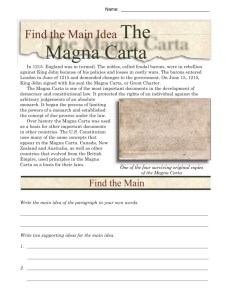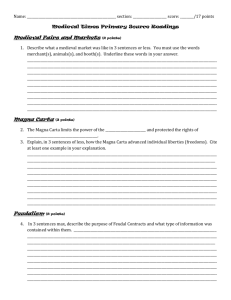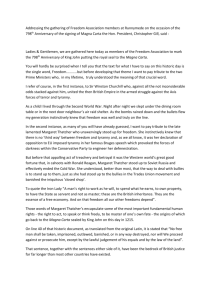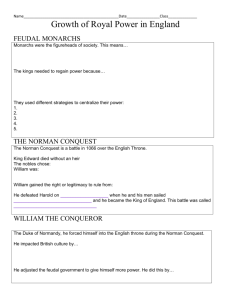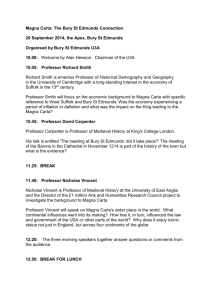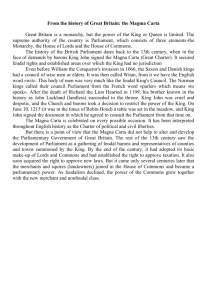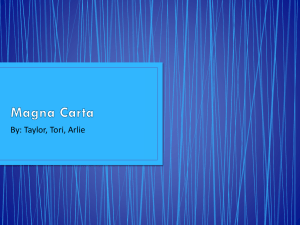Magna Carta Lecture - St Albans City & District Council
advertisement
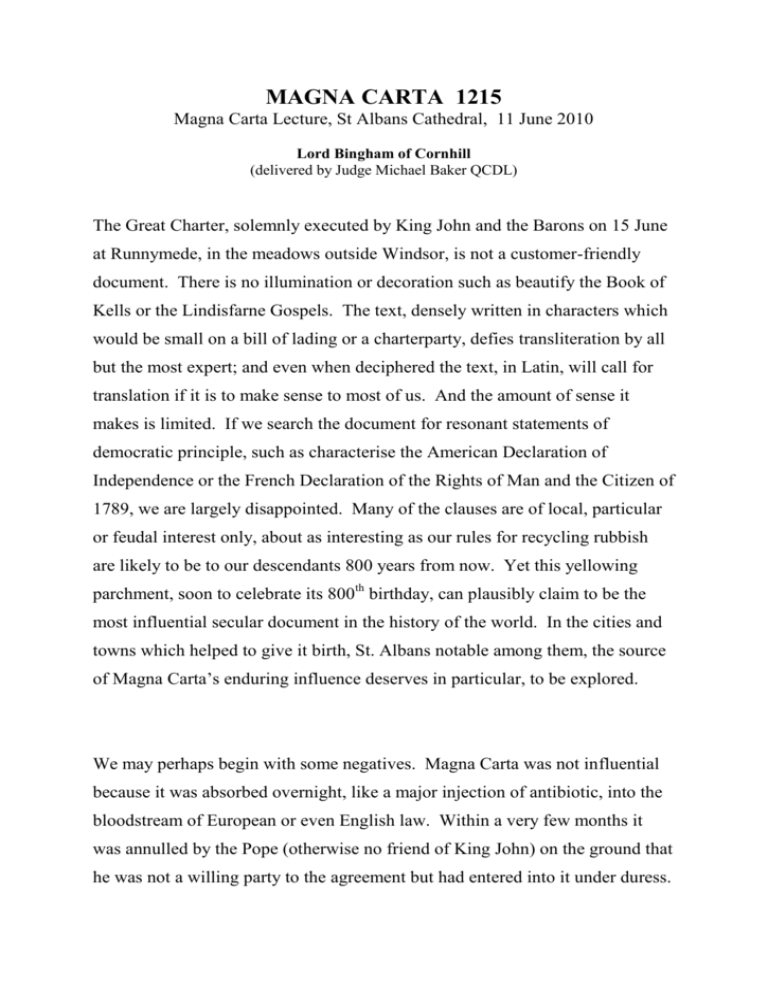
MAGNA CARTA 1215 Magna Carta Lecture, St Albans Cathedral, 11 June 2010 Lord Bingham of Cornhill (delivered by Judge Michael Baker QCDL) The Great Charter, solemnly executed by King John and the Barons on 15 June at Runnymede, in the meadows outside Windsor, is not a customer-friendly document. There is no illumination or decoration such as beautify the Book of Kells or the Lindisfarne Gospels. The text, densely written in characters which would be small on a bill of lading or a charterparty, defies transliteration by all but the most expert; and even when deciphered the text, in Latin, will call for translation if it is to make sense to most of us. And the amount of sense it makes is limited. If we search the document for resonant statements of democratic principle, such as characterise the American Declaration of Independence or the French Declaration of the Rights of Man and the Citizen of 1789, we are largely disappointed. Many of the clauses are of local, particular or feudal interest only, about as interesting as our rules for recycling rubbish are likely to be to our descendants 800 years from now. Yet this yellowing parchment, soon to celebrate its 800th birthday, can plausibly claim to be the most influential secular document in the history of the world. In the cities and towns which helped to give it birth, St. Albans notable among them, the source of Magna Carta’s enduring influence deserves in particular, to be explored. We may perhaps begin with some negatives. Magna Carta was not influential because it was absorbed overnight, like a major injection of antibiotic, into the bloodstream of European or even English law. Within a very few months it was annulled by the Pope (otherwise no friend of King John) on the ground that he was not a willing party to the agreement but had entered into it under duress. It was not enacted as a statute, as indeed it could not be in the absence of anything resembling what we know of as Parliament. The text of the Charter was not entirely new. While some of its provisions are novel, the draftsmen also did what any draftsman does in a situation of this kind: look for forms of words used in earlier instruments which can be adapted to the task in hand. Here, they could draw on earlier charters granted by King John’s Angevin and Anglo-Saxon predecessors, often issued on the king’s accession to the throne as a sort of non-election manifesto, a promise of good behaviour to secure the acquiescence of the people. So we must envisage the draftsmen, particularly in London, ransacking the archives to find material which could be used in this new situation. Still in negative mode, I pause to cull two myths of enduring potency: that the Charter enshrined the right to trial by criminal jury; and that it provided or safeguarded the remedy of habeas corpus. It did neither. It was only in 1215, the year of the Charter, that the Lateran Council condemned trial by ordeal, thus prompting the search for other modes of trial, a process which led over time, in England (but not in continental Europe), to trial by criminal jury. As for the cherished remedy of habeas corpus, its development – the work of the judges – lay in the future. If, however, the criminal jury and habeas corpus were not the direct product of the Charter, nor was the Charter in any way irrelevant to their history and development. Central to the historical importance of the Charter have been two chapters, numbered 39 and 40 in the original 1215 version. Even in translation they have the power to make the blood race. They read: “39. No freeman shall be seized or imprisoned or stripped of his rights or possessions, or outlawed or exiled, or deprived of his standing in any other way, nor will we proceed against him, or send others to do so, except by the lawful judgment of his equals or by the law of the land. 40. To no one will we sell, to no one deny or delay right or justice.” Both these chapters promised a curb on the exercise of power by the executive, since “we” can only have meant the king and the king was at the time the head of the executive, not only in the rather theoretical sense which endures to this day but also in a sense which was practically meaningful. Chapters 39 and 40 are, plainly, directed at different targets. Thus chapter 39 was aimed at practices all too familiar in the world today, if not (mercifully) in this country: the midnight knock on the door; the sudden disappearance; the prolonged detention, perhaps in a place unknown; the deprivation of status or citizenship, and of possessions, land or other rights; and all this on the arbitrary say-so of the executive, unaccountable and unchallengeable. Instead, adverse treatment must be by the lawful judgment of his equals or by the law of the land. But resort to legal process, however desirable, is a vain delusion if the process is in itself corrupt, or inordinately slow, or prohibitively expensive. What King John is promising is access to a legal system untainted by royal obstruction. While the substance of these chapters is remarkable enough in itself, even more so – perhaps – is the whole context. We have most of us, probably, been brought up in the belief that King John was a Bad Thing who was unsuccessful in war, provoked a damaging contest with the Papacy and oppressed his subjects with ruthlessly exacting taxes. It is difficult to know how much truth there is in this traditional picture, since the King suffered the misfortune that his history was written by his enemies, much of it here in St. Albans. But of one thing we may, I think, be sure: that King John was a highly energetic and effective monarch. He may have lacked the power, and even perhaps the desire, to please, of which King Richard III, according to Shakespeare, acknowledged the want. He may have been a poor communicator, closer in style to Gordon Brown than David Cameron. But it seems clear that he was a man of strong, perhaps even violent, personality; a man of action; a King conscious of the great power residing in the Crown and determined to exercise it; a man with no stomach for compromises. The significance of the Charter is the greater because it was granted by such a King, even if he was at the time, in the expression dear to the popular press of today, “beleaguered”, and not (for instance) by some pallid and insecure child during a regency. It would be a travesty to regard the Barons as a thirteenth-century precursor of Charter 88, seeking to implement a programme for the reform of our political institutions as they then were. Driven to rebellion by the King’s curtailment and denial of their feudal rights and privileges, this was their opportunity to attempt to secure that they would be respected in future. They were driven, not by an altruistic concern for the future of the country, but by an intention to protect their own particular interests. Establishment of a charter of human rights in the sense understood today was not among their objectives. Chapters 39 and 40 were important not as conferring rights on the subject but as imposing a restraint on the King. Conditioned as we are today by our own knowledge of political and constitutional development over the last nine centuries, it calls for the exercise of real historical imagination to appreciate the enormity, the grandeur of what was done at Runnymede. King John entered the meadow as a ruler acknowledging no secular superior, whose word was law. He left the meadow as a ruler who had acknowledged, in the most solemn manner imaginable, that there were some things even he could not do, at any rate without breaking his promise. This, then, is the enduring legacy of Magna Carta: the lesson that no power is absolute; that all power, however elevated, is subject to constraint; that, as was to be said by Dr. Thomas Fuller some centuries later, “Be you never so high, the law is above you”. The immediate shelf-life of Magna Carta 1215 proved, as already noted, to be short, but it was reissued on a number of occasions in the years that followed and was eventually, in slightly different terms, enacted as a statute. None of this transformed this country into a modern democratic state. Of course not. But it has been said that “Getting its history wrong is part of being a nation”. So it was with Magna Carta, as influential for what it was widely believed to have said as for what it actually did. The remedy of habeas corpus, developed by the judges to protect individual liberty, is a good example. The Charter, as already noted, did not enshrine or establish a right for the unlawfully detained subject, to apply for the issue of a writ of habeas corpus. But, however unhistorically, the judges appealed to the Charter when developing the remedy and it is very doubtful whether, without this all but sacrosanct instrument to rely on, they could have acted as boldly as they did. A further example may be found in the Petition of Right 1628. King Charles I was in urgent need of funds, since he wanted to conduct military operations abroad and the House of Commons refused to vote the necessary supply. So the King sought to raise the money he needed by imposing an involuntary loan on a number of gentlemen up and down the country who could afford to pay. Most did so without demur. But there were Five Knights, who gave their name to the ensuing case, who were less docile. They refused to pay and were committed to prison. They applied for habeas corpus. After an initial legal skirmish in which he was rebuffed, one of the knights gave up the battle. So then there were four. It is ordinarily incumbent on the addressee of an application for habeas corpus to specify the reason why an applicant has been detained, and this was the knights’ objective. They hoped that non-payment of the loan would be given as the reason for their imprisonment: they could then challenge and invite the court to investigate the lawfulness of the forced loan itself. But the Crown frustrated this hope. The return simply stated that the initial commitment and continued detention were “per speciale mandatum domini regis”, by his majesty’s special commandment. This was not a novel return in a case where commitment was by the King or the Council, and a bench of five judges headed by the Lord Chief Justice remanded the knights back to prison without further order. So their objective was, in the short term, defeated. The bland and uninformative return to the writ did, however, give rise to an obvious question, whether the exercise of royal power in this way was open to any, and if so what, legal constraint. The leaders of the Commons, invoking Magna Carta, claimed that the King was subject to the law. The outcome was the Petition of Right, accepted by a reluctant Lords and an even more reluctant King, and treated (anomalously) as a statute. Clause V of the Petition, after invoking the right to due process in the 1354 statutory revision of Magna Carta, provided: “Nevertheless against the tenor of the said statutes and other the good laws and statutes of your realm to that end provided, divers of your subjects have of late been imprisoned without any cause shown; and when for their deliverance they were brought before your justices by your Majesty’s writ of habeas corpus there to undergo and receive as the Court should order, and their Keepers commanded to certify the causes of their detainer, no cause was certified, but that they were detained by your Majesty’s special command signified by the lords of your Privy Council, and yet were returned back to several prisons without being charged with any thing to which they might answer according to law.” Then in clause VIII came the conclusion. “They do therefore humbly pray your most excellent majesty that no man hereafter be compelled to make or yield any gift, loan, benevolence, tax or such like charge without common consent by act of parliament, and that none may be called to make answer or take such oath or to give attendance or be confined or otherwise molested or disquieted concerning the same or for refusal thereof. And that no freeman in any such manner as is before mentioned be imprisoned or detained. And that your Majesty would be pleased to remove the said soldiers and mariners, and that your people may not be so burdened in time to come. And that the aforesaid commissions for proceeding by martial law may be revoked and annulled. And that hereafter no commissions of like nature may issue forth to any person or persons whatsoever to be executed as aforesaid, lest by colour of them any of your Majesty’s subjects be destroyed or put to death contrary to the laws and franchises of the land.” This was Magna Carta writ large, and with the authority of Parliament behind it, as was made even clearer by the Long Parliament in 1641. The message was the same: “Be ye never so high, the law is above you.” There can be no such thing as absolute, unchallengeable power. In contesting the absolutist pretensions of the Stuart kings, the parliamentary leaders found in Magna Carta an invaluable benchmark or gold standard, to which they could and did constantly appeal. By this time the Charter already enjoyed the venerability conferred by several centuries of constitutional tradition. It enabled the parliamentary leaders to present themselves as advocates of old traditions and values rather than inventors of new. And the Charter did provide incontrovertible evidence of acceptance by the Crown that its powers were not unbounded. The Glorious Revolution of 1688-1689 provided further (and since there was no question of duress) perhaps even more eloquent evidence. The precipitate flight from the country of King James II left the throne vacant. Ordinarily the death of one monarch is followed instantly and automatically by the succession of his or her heir. Queen Mary II, as daughter of King James II, was of course qualified to succeed, but the accession of herself and her husband, Prince William of Orange, was not instant and was not automatic. It was, instead, the product of a negotiation in which the Crown was offered, but offered subject to acceptance by William and Mary of certain conditions. These conditions, known to history as the Bill of Rights 1689, were finally accepted in the Banqueting House in Whitehall on Wednesday 13 February 1689. To 21st century ears, a bill or charter of rights suggests an instrument designed to confer rights on individuals. Such is the function of the European Convention of Human Rights, the International Covenant of Civil and Political Rights and other similar documents around the world. The 1689 Bill of Rights had a different object: it was to define the limits to which royal power was, if the newcomers accepted the throne, to be subject. So the monarch was not to rely on divine authority to override the law. The independence and authority of Parliament were proclaimed. The integrity of its proceedings was protected. There could be no standing army in peacetime without parliamentary sanction. The power to suspend laws without parliamentary consent was condemned as illegal. So was the power of dispensing with laws or the execution of laws “as it hath been assumed and exercised of late”. Personal liberty and security were protected by prohibiting the requirement of excessive bail and the infliction of “cruel and unusual punishments”. Jury trial was protected. When, and only when, William and Mary had signed up to these limitations on their authority were they allowed to accede. The contrast with the position of King Louis XIV across the Channel could scarcely have been more stark. If the appeal to Magna Carta proved a potent rallying cry for those who were concerned to limit the powers of the Crown in the domestic arena, the same was true on the international plane. As the eighteenth century wore on, British colonists settled on the eastern seaboard of North America became increasingly resentful of what they saw as the unjustified exactions and demands of the British Crown. They were not represented in the Westminster Parliament and could not, therefore, make their voices heard directly, in that forum. But the colonists had carried with them one priceless asset: the law of England, which of course included Magna Carta. For them, as for the seventeenth century puritans, the Charter provided a gold standard of proper government behaviour. But the colonists outstripped their English cousins in one respect: they invested the Charter with the status of a higher law, one which could not be broken. Here we find the root of the Americans’ most notable contribution to the constitutional development of the world: the establishment of a national Constitution, expressed to be the supreme law of the land, which is superior to all other laws and which cannot be changed save by a cumbersome process requiring a high degree of democratic validation. This is the constitutional model which now prevails in almost all the world, apart from New Zealand and the United Kingdom, which have chosen to treat Parliament and not an entrenched constitution as the highest authority in the state. The executive acting under an entrenched Constitution is not of course denuded of power: witness the extraordinary exercises of power by American presidents in recent years. But the principle is clear: President George W. Bush and President Obama, like all other public officeholders, are subject to the law which defines what they may do and also what they may – or should – not. The Americans have been generous in acknowledging their indirect debt to Magna Carta, by citing it in judicial judgments with increasing frequency as the years go by and, more tangibly, by erecting a monument at Runnymede to symbolise our shared legal heritage. Much more recently, and much less prominently, there has also been placed on the Runnymede turf a second monument, this time expressing a similar debt on behalf of the Republic of India. Thus the two largest free democracies in the world, both former colonies which have thrown off the imperial yoke to become independent, have returned to Runnymede to acknowledge the enduring applicability of the principle which found expression there so long ago. The terms of chapters 39 and 40 of Magna Carta 1215 would, even if they stood alone, deserve to be celebrated as a milestone in our national history. But it seems perhaps unlikely that these provisions would have enjoyed the celebrity they have had they not been recognised as giving rise to an ideal more comprehensive in its scope and more universal in its applicability. The ideal is what we now understand as the Rule of Law. That expression was not used until Professor A.V. Dicey first coined it in 1885 in his Introduction to the Study of the Constitution, and embodies much, as I would suggest, that cannot possibly be spelled out of Magna Carta. But the Charter provides a building block which has been crucial in developing our modern notion of the Rule of Law. As now understood, the core of the existing principle of the Rule of Law is that all persons and authorities within the state, whether public or private, should be bound by and entitled to the benefit of laws publicly made, taking effect (generally) in the future and publicly administered in the courts. That is something of a mouthful, and may savour of legal mumbo-jumbo. But it is really a compendious way of gathering within a single principle rules which, spelled out, will strike most of us as obvious. I shall touch on eight such rules. 1. The law should be accessible and so far as possible intelligible, clear and predictable. The reason is not far to seek. We cannot perform our duties as citizens to obey the law – as we know we should – unless we know, or can with reasonable ease find out, what the law is. Equally, we cannot avail ourselves of rights and benefits which the law gives us unless we know, or can with reasonable ease find out, what they are. In a society such as ours, in which (literally) thousands of pages of primary and secondary legislation are churned out, year after year, this is not a negligible problem. It is, one may add, a problem compounded by the length and prolixity of many judicial judgments, particularly those delivered in the higher courts. 2. Questions of legal right and liability should ordinarily be resolved by application of the law and not the exercise of discretion. As Magna Carta puts it, “according to the law of the land”: not according to personal prejudice or predilection of King John, or any later minister, official, administrator or judge. This is not a plea for a society hamstrung by a mass of bureaucratic rules, but it does recognise that if a decision rests unchallengeably within the unguided discretion of an official decision-maker the outcome may be arbitrary, even whimsical, inconsistent, unpredictable and unfair. That some measure of discretion should exist – in relation, for example, to the sentencing of criminals – is undoubted, but the factors which may be relied on to guide a discretion should always be clear. 3. The laws of the land should apply equally to all, save to the extent that objective differences justify differentiation. Thus Magna Carta applied to “all free men”, which comprised the mass of the population, not just the barons and their relations. Sometimes, of course, the law can properly distinguish particular classes of people because they are, in a material respect, different: children, for example, or mental patients, or immigrants with no right of abode. Where this particular feature is in issue, differentiation of treatment may be justified. But the general rule is clear: we are all subject to the law; we are all entitled to its benefits; in the absence of compelling justification, we should all be treated equally, whether we be rich or poor, white or black, Christian or Muslim, town dweller or countryman. 4. Ministers and public officers at all levels must exercise the powers conferred on them in good faith, fairly, for the purpose for which the powers were conferred and not unreasonably. This rule recognises, as did Magna Carta, that public power is held on trust, not as a privilege conferred on its possessor. So while we would readily accept that in a complex society such as ours power must necessarily be conferred on many ministers, officials, administrators and judges, we do not give any of them, ever, a blank cheque to draw on as they choose. The power is given for a purpose, which must be honoured. 5. The law must afford adequate protection of fundamental human rights. The legal protection of human rights was not, as I have suggested, the focus of Magna Carta. But the prohibition of unlawful seizure and detention, coupled with that on official obstruction of legal process, was an important beginning and the Bill of Rights 1689, even if incidentally, offered important safeguards to the individual. It would, today, be hard to approve of a society which did not offer adequate protection of such human rights as were regarded, in that society, as fundamental and indispensable. It is an important ingredient of what we now understand by the Rule of Law. 6. Means must be provided for resolving, without prohibitive cost or inordinate delay, bona fide civil disputes which the parties themselves are unable to resolve. We do not wish to live in a society of litigious activists, and almost any consensual way of resolving a civil dispute is ordinarily preferable to an imposed solution. But our culture does not countenance aggressive self-help, private vengeance or vigilante justice. So, in the last resort, we ought – all else having failed – to be able to go to court to assert or defend what we believe to be our rights. The problem is that access to the court may be prohibitively expensive or inordinately slow. This is not a new problem. Nor is it one we have solved. The promise made in chapter 40 of Magna Carta remains to be performed. 7. Adjudication procedures provided by the state should be fair. In other words, we are all entitled to a fair trial, whether of a criminal charge or of an accusation which, although not criminal, can have adverse consequences if decided against us – denial of parole, for instance, or discharge from a mental hospital. The essential ingredients of a fair trial, whatever the form of the proceedings, are well-understood. They include clear notice of what a person is said to have done wrong; time and facilities for that person to prepare his defence, with professional help if necessary; an opportunity to confront and challenge witnesses giving evidence against him and to give and call evidence on his own behalf; and a decision-maker who is independent of the parties and of any extraneous authority, approaching the issues with an open mind. The requirements of procedural justice change over time, sometimes quite markedly. But the right to a fair trial has been recognised as absolute, and the draftsmen of chapter 39 made no allowance for exceptions in times of emergency or civil strife, with which they were very familiar. 8. The rule of law requires compliance by the state with its obligations in international as in national law. Here we step outside the confines of Magna Carta. It was directed to the exercise of power by the King within his realm, not with relations between one state and another. But the Rule of Law cannot stop short at national boundaries because the problems which we face in our world today – climate change, pollution, financial regulation, crime, migration – do not stop short at national boundaries. The lesson, however, is the same. As kings are subject to the law and not above it at home, so states are subject to the law and not above it in their relations with other states. On acceptance of this lesson, it might be thought, depend the peace and prosperity of the world. It is not a lesson which Magna Carta taught, but it is an extension of the principle which Magna Carta so memorably gave to posterity around the world.


